A Paipo Interview with Paul Witzig
July 27 and August 13, 2011 - Maclean, NSW Australia
Phone interview by Bob Green
Paul has described three phases of prone surfing during the course of
his life. This last phase was prompted by his desire to stay in the
water and to keep surfing. More than a "geriatric surfing aid," prone
surfing has allowed Paul to continue to take off deep, riding an
innovative bellyboard with horns.
|
1. I received an e-mail from a
guy describing you riding an interesting sounding bellyboard. I'm not
sure about the details and if it is accurate?
For me, the situation was -- I'm now 71 years old -- when I got to about
age 60, my knees were starting to cause me trouble and at times I was out of
the water for a few months at a time waiting for my knees to come back
together again. It's a family thing. I've been stand-up surfing all my
life since I was 11. At one point, I figured out that I didn't really
have to stay out of the water and that what I ought to do, is make a
bellyboard and ride lying down. The thing that had really spurred that
on was that as my knees had started fucking up, I would occasionally
prone out. Actually, when I really started surfing, back when I was 8 or
9 years old, I always rode a surfoplane before I got my first board. I
had ridden lying down many times.
Getting
back to when I was 60, I thought, "If I do that I'm also going to be
wearing flippers and that will strengthen my knees and there are going
to be pluses all around." I've been making my own boards for a long
time and using deep concaves. I used one of my surfboard templates and
cut it down to about 5'6". I made a board designed for lying down as a
bellyboard. I've been using twin fins and it is a twin fin. I put a
deep concave through about the first 60 percent of the board, then I
flattened it out as it went through the fins. I wanted to use a deep
concave up front so that I could get steering
control. The first board I put some rope handles up the front to hang
onto. I quickly figured out that this was not too smart because it
didn't give me any steering control so I ripped the rope handles out
and I designed, what look like horns with round bulbs at the end and I
mounted it about probably six inches back from the nose. It was
fabulous. It just gave me
a lot of control and the boards are very fast. So it just brought me
into a new type of surfing that enabled me to stay in the water. It
meant I could take very late drops again, I could free-fall. Lots of
things that I hadn't been able to do for a while and I've been riding
them ever since.
So you are still riding them?
Yeah, yeah. I'm probably on my sixth, seventh or eighth.
2. Are the photos that you sent your current board?
Yes it is.
Paul with three of his boards. The board on the far
left is made of balsa, the middle board is Paul's current board and the
board next to Paul originally had a scooped out deck. Polystyrene was
later added to try and recover flotation.
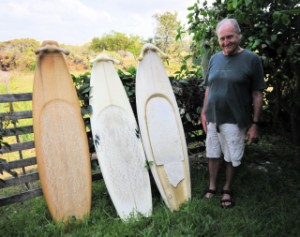
Photo courtesy Paul Witzig.
Regarding the horns, how did you make and attach them?
After I pulled the rope handles off I started thinking of riding a bike
and I realized that if you tried to ride a bike without handlebars that
you would have great difficulty in controlling it. So I applied the
same thinking to designing some steering handlebars for the bellyboard.
They had to have knobs at the end that fitted comfortably in the palm
of your hand. That was important. The other thing is that you were
likely to come into contact with them fairly often in wipeouts and
stuff, so they had to be rounded and blunt. The width of them just came
naturally to mind. I've tried about three or four different designs of
these things - longer ones, shorter ones, higher ones, lower ones. This
is where it has got to and it works very well.
They are made out of foam, I carve them out of foam. The glassing is a
long, drawn out and tedious process. It's difficult to glass that
shape. What I do is cut long strips of glass, like a bandage and then
wrap them round and round and round and round and round and round,
saturating them with resin. Sand them back, then go again, sand them
back, then go again, because they have to be really, really strong. Not
just to survive wipeouts but also to survive impacts and stuff. So I
simply attach them with fiberglass.
I had wondered if you had molded them. Do the horns
get in the way during a wipeout?
No, but on two or three occasions I've snapped them off at the shaft by
holding onto them during a wipeout.
The horns from
above and below.
|
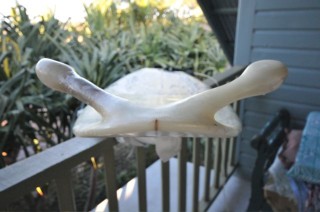
|
|
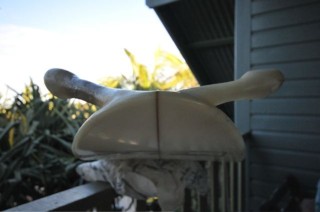
|
Photos by Paul Witzig.
In terms of actually turning the board, do you solely
rely on the horns?
No, you rely on everything. You rely on body positioning, you rely on
your fins, you rely on the steering handles and where you weight them,
it's all a combination.
So it is leg pressure, hip pressure and whatever
leverage you get from the horns?
But they give you a lot more leverage up front. The very deep concave at the front really allows you
to steer by positioning your front rail and then you can slide the back
out if you want.
3. The fins are also fairly unique - are they used on
your stand-up boards or specially made for the prone boards?
No, I shaped the first five or six boards myself and then I've got a
friend close by here who has made the last three for me just using my
previous boards as a template. He suggested I try these fins which I
did. That board that you are looking at was made about five years ago.
I've been riding it ever since and it's quite likely that Mario would
like to put different fins on a new board but I've been very happy with
those.
How high are the fins?
About 150 mm, maybe a little more.
What's that in inches?
Six to seven inches.
Twin fins in
profile and recessed deck.
|
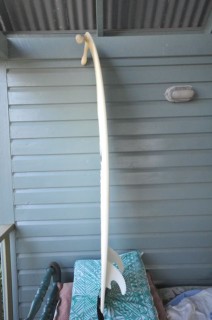 |
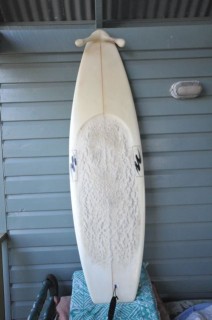 |
Photos by Paul Witzig.
4. What's the thinking behind the step deck?
I just wanted the body to sit comfortably in a recess.
So it is basically comfort?
And it stops you sliding forward. It holds you in position on the
board. There's really a concave there that the body sits in.
5. You mentioned that the board is about 5'6". How wide
and how thick is it?
It's around 18" wide and it could even be a touch narrower. It's about
1-3/4 or 1-7/8 inches thick.
So it's thinner than a stand-up board?
It's thin. I wanted to cut flotation down as much as I possibly could.
What was thinking about cutting down the flotation?
My experience has been that thinner boards perform better on the wave.
On top of that they're easier to duck dive, easier to get out with
through broken surf, though they are slow to paddle. There are plenty
of times where I haven't been able to get out because I'm a very slow
paddler with a board.
Do you arm paddle or kick?
Paddle on the way out, paddling and fins to get onto the wave. I also
use the fins for directional control while riding the wave. That's one
of the sweetest controls that I have.
6. Do your prone boards differ much from the design that
you had for stand-up boards?
Not a lot, except that the planshape came originally from a template I
had from Reno Abellira about 20 years ago. I've made my boards almost
all my life and for the last sort of five or ten years of stand-up
boards I've ridden deep concaves with a twin fin. So I transferred the
deep concave and twin fin over to the bodyboard, except I decided I
would deepen it in the front and just taper it out to flat between the
fins to make it looser in the tail.
Reno Abellira inspired planshape.
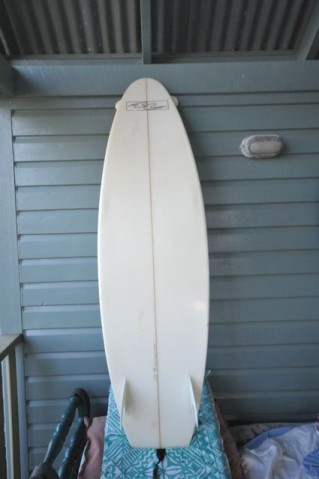
Photo by Paul Witzig.
It's thinner so has less volume. How about the wide
point and the rails - are they pretty similar?
Yeah, they were. One other thing, I squared off the nose to reduce the
length. The nose is quite wide. It's really square-rounded.
The bottom
curves, from the front and back.
|
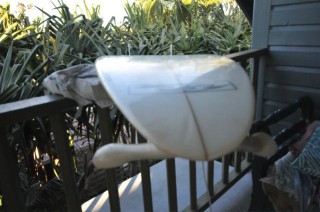
|
|
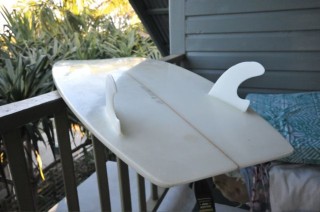
|
Photos by Paul Witzig.
7. Has the design changed much from that first prone
board?
I've tried all sorts of things. I tried one where I hollowed all that
body recess like Greenough's spoon. There was no flotation there at all
except in the rails. That was a total failure.
In what way?
All the flotation was up the front of the board. It became quite
awkward to paddle around and get onto a wave.
Once you got onto a wave what was it like?
It was ok but it certainly wasn't as good as the other one.
So the flex wasn't magical?
No, it wasn't. No, I had been expecting something like that but it
didn't work out.
I made one out of balsa which was a bit flat, there is quite a lot of
bottom rocker in this board. The balsa one was flatter but had pretty
much the same planshape, but longer handles. They came back a bit
further into the body of the board. That was very, very fast but it
didn't handle, wasn't as manoeuvrable. Manoeuvrability is a big deal.
You got to be able to position it where you want in the pocket. You got
to be able to take very, very late drops and the bottom curve is very
important for that.
The balsa board is on the far left, Paul's current
board is in the middle and the 'spoon' is on the right.
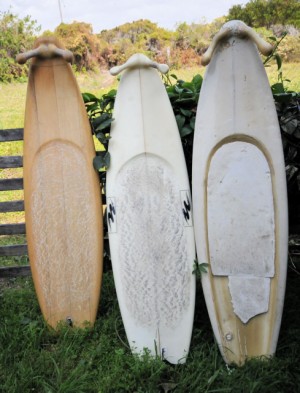
Photo courtesy Paul Witzig.
I wanted to also ask how you get speed because you
can't pump these boards?
The right place on the wave. You've got to put it in the right place,
that's why maneouvarability is so important.
So the board you have now is a good compromise between
speed and control?
Yes, in my opinion.
8. If you were going to make another board, what would
it be like?
It would be exactly the same but a bit thinner.
A thin foil.
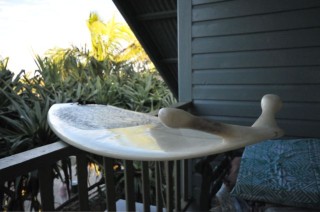
Photo by Paul Witzig.
How much thinner would you go?
I've been arguing with Mario about this one. He wants to make it
thicker and wider. I want to make it thinner. Probably take a quarter inch
(1/4") out of it. From my experience, thinner is better until you get to a
point that you can't paddle the bloody thing. I'm trying to get almost
to that point. I'm getting older and I'm not getting any stronger. I
have to think of that as well.
So there is a board in your head?
Yeah, but it's an evolutionary thing not a radical change. I've tried a
number of different variants on this basic board. At the moment I've
got three boards reasonably similar to the photo I sent and I've got
another couple tucked away.
Weight is also an issue. The first few boards I made are glassed with
epoxy and used a cross weave. I couldn't get Mario to do that. That
board you are looking at just has normal resin. It has a quite a few
crows marks across it.
So how much glass is on it?
I think two layers of six or eight. You get more strength if you glass
with epoxy and you get more strength if you glass on the 45 degree
angle.
9. What sort of waves have you built it for?
I'm normally riding waves between 3' and 6'. Sometimes a bit bigger. I
surf in northern New South Wales and in Papua New Guinea. It's the same kind of wave size. I
normally surf reef breaks.
And are there any waves that you can remember riding
on your board?
Many, many, many. I've probably had more fun on this type of board than
I've had on any board before.
What do you enjoy about riding prone?
That I can simply keep on surfing. If I was limited to stand-up I would
have been out of the water for quite a while now. That's the issue,
keep on surfing.
10. What has been the attraction of this style of
surfing?
Get deeper, take later takeoffs and one thing you notice as you get
older, you move down the pecking order in the lineup. When I first got
this board I could go right up to the top again. That was important. I
look at it as a geriatric surfing aid.
The other reason I did it is that my knee screwed up and I could keep in the
water, keep surfing. If I moved to a board of this kind where I was
continuing to exercise my knees with the paddling and the kicking I
could keep surfing for the rest of my life and that has worked out
really, really well.
Most people when they get their geriatric surfing aid
go much longer and thicker.
I think that is stupid. You got to keep your involvement. The thicker
you go, the longer you go, the less involvement you have in my opinion,
until you end up being one of those idiots with a stand-up board totally
disconnected with the wave face.
They often don't use the best part of the wave.
They can't. They are riding a tanker.
11. In you travels have you seen other people riding
paipos or bellyboards?
No, I haven't but I am absolutely convinced that in the Pacific Islands
riding waves began using bits of wood and bits of broken canoe to catch
waves in a prone position. I'm absolutely certain about that. Anything
else came later and evolved from that and it's still going on.
Madang area
surfcraft blending into the environment.
|
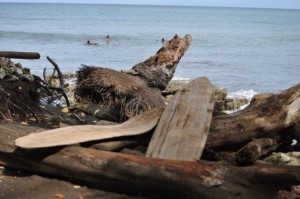
|
|
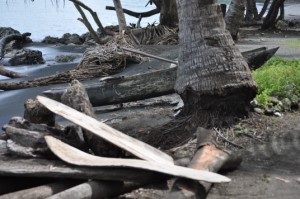
|
Photos by Dan Perrier [Note 1].
You may have seen that series on the ABC called
"Islands of the Pacific." It featured footage of Anutan kids riding what
looked like oars. I wondered whether another origin of surfing is when
a boat got wrecked, people grabbed timber or an oar and were washed
into shore.
In Papua New Guinea, when a canoe gets broken the kids grab bits of that to start
surfing on in that way, lying down. So the tradition of surfing in this
way goes back for centuries. It goes back a long way. It's great.
12. It shows you can have a lot of fun with not much
equipment?
It does. It's still happening and that's where it all began for me as a
kid growing up. The first thing I had to surf on was a surfoplane. I
spent quite a few years surfing surfoplanes. Then when I was making
movies Greenough got me a surf mat and I would carry a deflated surf
mat and flippers around with me, along with my camera equipment.
Wherever I was I could get out in the water. So I've had three phases
of prone surfing in my life.
You didn't go back on a mat this time, what prompted
you to try a bellyboard?
Surf mats are fun, but they're not high performance surfing equipment
in my mind.
There is a long learning curve to be able to ride a
mat like Greenough.
Yeah, it's true. They all have their place. I think the boogie board
was the greatest invention by Tom Morey [see Note 2]. It has stood the test of time
and there are millions of them all over the planet. You can ride them
in a high performance way. They can get deep, take deep drops and do
radical things on them.
Some of those young guys are pretty amazing.
Absolutely.
You have the vacuum rails and the flex, you can get
reverse rocker with them.
Well correct, obviously you can do that with a mat, it's one of the
subtleties of mat riding. The boogie board is truly a great thing.
13. People look down on prone surfing without seeing the
depth behind it?
That's a great thing. I'm more than delighted that it is unfashionable,
untrendy and not cool. Obviously boogie boards are mainstream. You
can't negate that. It's the way most kids start to surf really. That's
been the most influential type of prone surfing, I imagine, by far.
What I find interesting is people coming from their
own direction, to come up with functional designs independent of others?
Absolutely true. I've given a couple away over the years and I've had
endless comments about "what's that weird thing"?
|
Note 1: For
more of Dan's photos see O'Brien, D. (2011). Tupira. Pacific
Longboarder, 15(1) 62-65.
Note 2: Below is the third Morey boogie advertisement appearing in Surfer Magazine.
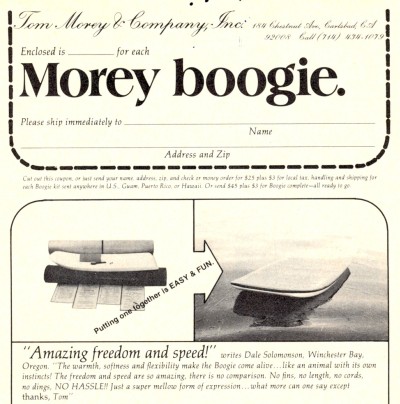
Source: Morey boogie [Advertisement]. (1974, October/November). Surfer Magazine, 15(4), 13. |
Other info: To see Paul's art, architecture and
surfing images, click here.
|
|